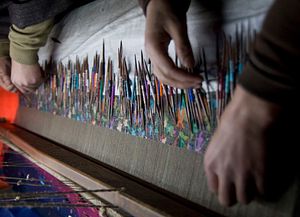The art of weaving was introduced in the Kashmir Valley in the late 15th century by the King Zain-ul-Abidin, who had imported the art from Persia. Kashmir carpets and shawls still follow that tradition of intricate geometric and calligraphic motifs; their beauty lies in the detailed needlework. The art flourished during the time of the Mughals and the tradition continued even during the troubled times of Afghan and Sikh rule. When the British arrived in the early part of the 19th century, a certain utilitarianism came into the art that commercialized the woven products and Kashmiri carpets and shawls became the cynosure of connoisseurs’ eyes all over the world.
The industry suffered a setback when the valley was engulfed in turmoil in 1989. With Indian military forces and separatists locked in a brutal and long-drawn conflict, the ancient craft of weaving fell into troubled times. Export orders dried up and inbound tourism hit an all time low. A lot of artisans fled the valley, creating a void.
Two and a half decades later, the valley has entered another crucial juncture and the lives of ordinary Kashmiris are threatened yet again. For the last four years, there had been a period of relative calm and the weavers and businessmen were beginning to get hopeful for a better future. Now, with escalating violence in the valley yet again, their dreams of rebuilding the ancient craft industry is fading.
And the industry is plagued by other handicaps. The cost of raw materials, namely the wool of the pashmina lambs, has become prohibitively expensive; the market is abound with cheaper domestic substitutes, and, most importantly, the young generation of Kashmiris seems entirely uninterested in mastering the skill of weaving due to the low pay in this sector.
But the singular problem threatening this beautiful craft is the continuing turmoil that saw Kashmir dubbed as one of the deadliest zones on the planet. The people of the valley fear that the ancient craft of Kashmiri weaving may soon be a relic of the past.
Sugato Mukherjee is a photographer and writer based in Calcutta and his works have appeared in The Globe and Mail, Al Jazeera, National Geographic Traveler, Harper Collins and Yale University Journal. His coffee table book on Ladakh has been published from Delhi in 2013. Some of his visuals and stories can be found at http://sugatomukherjee.zenfolio.com/













































